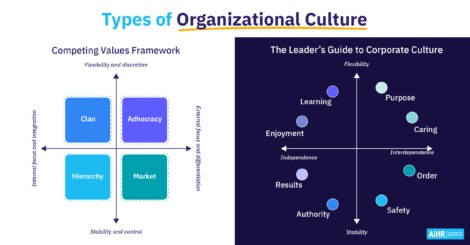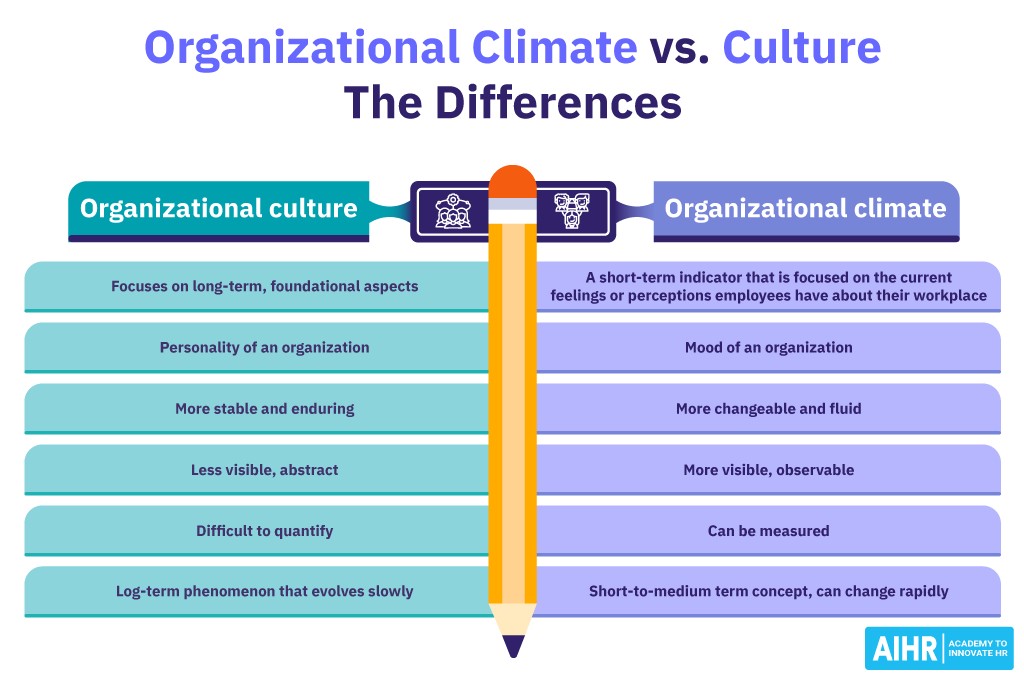Compare and contrast organizational culture and climate to understand their distinct impacts on employee experience and overall business success. This guide, brought to you by COMPARE.EDU.VN, provides an in-depth analysis of these concepts, highlighting their differences, connections, and practical implications for fostering a thriving workplace. Discover how aligning culture and climate can drive employee engagement, improve performance, and create a more positive and productive work environment, leading to enhanced business outcomes.
1. Defining Organizational Culture
Organizational culture encompasses the deeply ingrained values, beliefs, and behaviors that shape a company’s identity. It’s the foundational set of principles, both explicit and implicit, that guide how employees interact with one another, engage with clients, and make decisions within the organization. These cultural elements dictate the norms and expectations, influencing everything from communication styles to problem-solving approaches. A strong, well-defined organizational culture fosters a sense of shared purpose and commitment, leading to greater employee satisfaction and a more unified workforce. Companies with thriving organizational cultures often experience higher levels of innovation, engagement, and overall performance.
In a global study, Gallup found that less than a quarter of employees (23%) were engaged. Weak cultures often stifle creativity and lead to dissatisfaction and disengagement whereas strong cultures are a tonic for innovation, engagement, and high performance.
2. Understanding Organizational Climate
Organizational climate reflects the prevailing emotional atmosphere and current perceptions of the workplace. It captures how employees experience and feel about their work environment, influenced by factors such as leadership styles, communication practices, workload demands, and recognition programs. A positive organizational climate fosters a sense of belonging, motivation, and high performance, as employees feel supported and valued. Conversely, a negative climate can lead to disengagement, stress, and decreased productivity, hindering overall business goals. Effective leaders understand the importance of nurturing a positive climate by promoting open communication, providing regular feedback, and fostering a supportive and inclusive work environment.
3. Key Differences Between Organizational Culture and Climate
To effectively manage and improve the work environment, it’s crucial to understand the distinctions between organizational culture and climate. While both concepts are interconnected, they operate on different levels and timeframes, influencing employee behavior and organizational performance in unique ways. Here’s a detailed comparison highlighting their key differences:
| Feature | Organizational Culture | Organizational Climate |
|---|---|---|
| Focus | Longer-term, foundational aspects including core values and beliefs that define ‘how things are done’ within the organization. | Shorter-term, focused on current feelings and perceptions employees have about their workplace. |
| Analogy | Personality of an organization: Represents core characteristics and underlying traits that define the organization. | Mood of an organization: Reflects the current emotional state or feeling within the workplace, which can change frequently. |
| Stability | More stable and enduring: Evolves slowly over time and is generally more resistant to change due to its deeply ingrained nature. | More changeable and fluid: Can fluctuate readily based on current events, leadership changes, or new policies. |
| Visibility | Less visible, abstract: Consists of unspoken norms and values, making it challenging to directly observe and measure. | More visible, observable: Apparent through employee interactions, work environments, and communication styles. |
| Measurement | Difficult to quantify: Assessing culture often relies on observation, interpretation of behaviors, and employee feedback through pulse surveys or focus groups. | Can be measured: Climate surveys, employee feedback sessions, and exit interviews can provide data on employees’ feelings and perceptions of their work environments. |
| Time Frame | Long-term phenomenon, evolves slowly: Built and reinforced over time through experiences, leadership actions, and established practices. | Short-to-medium term concept, can change rapidly: Can shift quickly in response to new leadership, policy changes, or unforeseen events. |
| Impact on Behavior | Shapes long-term behaviors and attitudes, influencing how employees approach their work and interact with others. | Influences immediate behavior and motivation, impacting daily productivity and job satisfaction. |
| Influence Factors | Deep-rooted values, historical events, leadership philosophies, and ingrained norms. | Leadership styles, communication effectiveness, workload balance, recognition programs, and immediate work environment. |
| Change Process | Requires significant effort and time to intentionally change, often involving a strategic, long-term approach. | Can be influenced more rapidly through targeted interventions, policy adjustments, and changes in leadership behavior. |
| Relationship | Provides the foundation upon which the climate is built, influencing the overall tone and atmosphere of the workplace. | Reflects the current manifestation of the culture, providing insights into whether the espoused values are being lived out in practice. |
| Focus Areas | Values, beliefs, assumptions, norms, and traditions. | Attitudes, perceptions, morale, relationships, and day-to-day experiences. |
| Assessment Tools | Qualitative assessments, ethnographic studies, in-depth interviews, and cultural audits. | Quantitative surveys, employee feedback platforms, pulse checks, and performance metrics. |


4. The Interconnection Between Climate and Culture
Organizational culture and climate are interconnected concepts, often described as two sides of the same coin. Culture establishes the long-term values and beliefs that dictate how things are done, while climate reflects the current experience of the work environment based on those cultural norms. For culture and climate to function well together, they must be aligned. For instance, if a company claims to value work-life balance (culture) but consistently demands long hours or after-hours accessibility from its employees (climate), there is a misalignment. Conversely, a workplace with a strong, positive culture encourages healthy climates, positively impacting morale, motivation, and performance. A positive climate can also support an organization’s cultural goals, nurturing its culture over time.
This close relationship means that HR professionals must consider both elements to create a functional and healthy work environment. Addressing one without the other can lead to missed opportunities for improvement and a disconnected employee experience.
5. Examples of Positive Organizational Cultures
Several companies are renowned for their positive organizational cultures, which significantly contribute to their success and employee satisfaction. Here are a couple of prominent examples:
5.1. HubSpot
HubSpot consistently ranks among the best companies to work for, largely due to its focus on company culture. The company views its Culture Code as a perpetual work in progress, updating it regularly to reflect evolving values and priorities. HubSpot recognizes that a great culture attracts top talent, simplifies recruiting, and strengthens the culture in an ongoing improvement loop. During the recruitment process, HubSpot emphasizes candidates with ‘H.E.A.R.T.’—Humble, Empathetic, Adaptable, Remarkable, and Transparent.
To further enhance its culture, HubSpot hires for ‘culture add’ rather than ‘culture fit,’ actively seeking new employees who can challenge existing norms with unique experiences and ideas while embodying the company’s core values.
5.2. Lego
Lego embodies the joy of play and creativity in its company culture. Believing that restrictive environments stifle innovation, Lego fosters a culture that values creative freedom and imaginative thinking. The company challenges employees to find unique and fun ways to solve problems, giving them autonomy and room to grow. This creative spirit is evident in Lego’s playful office design, open management style, products, and overall culture.
6. Examples of Positive Organizational Climates
A positive organizational climate is characterized by employees feeling valued, supported, and motivated. Here are a few examples of companies known for fostering such an environment:
6.1. Google
Google prioritizes creating an environment where employees feel comfortable testing new ideas, voicing opinions, and learning from mistakes. The tech giant nurtures ‘psychological safety’ by supporting individuals in taking risks and being vulnerable among coworkers. This climate allows high-performing teams to flourish, driving continuous innovation and improvement.
6.2. Nordstrom
Nordstrom maintains a servant leadership approach, placing customers and frontline employees at the top of its organizational structure. This commitment to providing high-quality service to both customers and staff positively impacts the company’s climate daily. By prioritizing the needs of its employees, Nordstrom fosters a supportive and engaging work environment.
7. Best Practices for HR Professionals in Developing Climate and Culture
HR professionals play a critical role in developing and maintaining both a robust organizational culture and a positive climate. Here are some best practices to guide HR in shaping these essential aspects of the workplace:
7.1. Building a Positive Organizational Culture
A strong organizational culture provides the foundation for a positive work environment, leading to engaged and loyal employees. HR can help shape this culture by:
- Defining Core Values: Clearly define, articulate, and reinforce the core values that represent the company’s beliefs and shape desired behaviors. Hire based on these values and consistently reinforce them through onboarding, training, and performance reviews at all levels.
- Empowering Employees: Set clear expectations and parameters for employee behavior and performance, then involve employees in decision-making and provide autonomy in their work to create a sense of ownership.
- Building Trust and Transparency: Encourage open communication through regular surveys, town halls, and anonymous feedback channels. Actively listen to employee concerns and address them promptly.
- Reinforcing Through Recognition and Rewards: Implement programs that celebrate individual and team accomplishments aligned with the company’s core values. Show appreciation for employees who demonstrate behaviors that align with the culture.
- Investing in Training and Development: Offer opportunities for managers and employees to grow their skills and knowledge in line with company goals. Promote an environment of continuous learning to foster innovation, self-management, and problem-solving.
- Promoting Diversity and Inclusion: Build a diverse workplace where everyone feels valued, respected, and empowered to contribute their unique talents.
- Celebrating Culture: Organize events and activities that reflect the organization’s values and foster a sense of community. Encourage employee participation in building a vibrant company culture.
7.2. Building a Positive Organizational Climate
Climate reflects the current atmosphere within the organization and can shift quickly. HR can work to improve the climate by:
- Focusing on Leadership: Ensure leaders and managers at every level support core values and model ideal behaviors. Create a culture of accountability where everyone is held to the same standards and implement feedback mechanisms to address toxic behaviors.
- Combating Stress and Burnout: Promote a healthy work-life balance by offering flexible working arrangements and encouraging breaks. Discourage long hours and constant availability to address burnout.
- Enhancing Communication and Feedback: Foster clear and transparent communication from leadership and encourage open dialogue through two-way channels and regular feedback opportunities.
- Prioritizing Employee Wellbeing: Implement holistic wellness programs that include mental health support, and design workspaces to enable interaction, collaboration, and productive focus time.
- Addressing Conflict Resolution: Establish clear procedures for addressing conflict promptly and fairly. Champion an environment that values respect and understanding, and train managers and employees in effective communication and conflict resolution skills.
- Measuring and Improving: Conduct regular surveys or focus groups to assess employees’ perceptions of their work environment. Use the data to identify areas for improvement and address climate concerns as they emerge.
- Remaining Adaptable: Recognize that climate can evolve quickly and be prepared to adapt programs based on changing circumstances and employee feedback.
8. Actionable Steps to Improve Organizational Culture and Climate
To create a thriving workplace, it’s essential to take concrete steps to enhance both organizational culture and climate. Here are actionable strategies that can be implemented to achieve this goal:
- Conduct Regular Assessments: Implement surveys and feedback sessions to gauge employee perceptions of the current culture and climate. Tools like pulse surveys and anonymous feedback platforms can provide valuable insights.
- Develop Leadership Training Programs: Equip leaders with the skills to foster a positive climate, including communication, empathy, and conflict resolution. Training should focus on modeling desired behaviors and supporting team members.
- Implement Recognition Programs: Create formal and informal ways to recognize and reward employees who exemplify the company’s core values. This reinforces positive behaviors and boosts morale.
- Promote Work-Life Balance Initiatives: Offer flexible work arrangements, wellness programs, and mental health support to reduce burnout and improve employee wellbeing.
- Establish Clear Communication Channels: Ensure transparency by providing regular updates on company performance, decisions, and changes. Encourage open dialogue and feedback at all levels.
- Foster a Culture of Continuous Learning: Invest in training and development opportunities that align with company goals. Support employees in acquiring new skills and advancing their careers.
- Address Toxic Behaviors Swiftly: Implement clear policies for reporting and addressing negative behaviors. Take prompt action to resolve conflicts and maintain a respectful environment.
- Create Inclusive Policies: Ensure that policies and practices support diversity and inclusion, promoting a sense of belonging for all employees.
- Organize Team-Building Activities: Encourage social interaction and collaboration through team-building events, workshops, and social gatherings.
- Regularly Review and Adapt: Stay informed about changing circumstances and employee needs. Be prepared to adjust programs and initiatives based on feedback and evolving priorities.
9. The Importance of Alignment for Success
For an organization to thrive, there must be strong alignment between its culture and climate. When these elements are in sync, employees are more likely to feel engaged, motivated, and committed to the company’s goals. Misalignment, on the other hand, can lead to dissatisfaction, decreased productivity, and high turnover rates. Achieving alignment requires a concerted effort to ensure that the values espoused by the organization are reflected in the daily experiences of its employees.
A culture that values innovation should create a climate that encourages experimentation and risk-taking. A culture that prioritizes customer service should foster a climate in which employees feel empowered to go the extra mile for customers. By carefully managing both culture and climate, organizations can create a cohesive and supportive environment that drives success.
10. Addressing Common Questions About Organizational Culture and Climate (FAQ)
10.1. What is the difference between organizational culture and climate?
Organizational culture is the long-term, foundational values and beliefs that shape a company’s identity, while organizational climate reflects the current emotional state and perceptions of the workplace.
10.2. Why is organizational culture important?
A strong organizational culture fosters a sense of shared purpose, enhances employee engagement, and drives innovation and high performance.
10.3. How can a positive organizational climate benefit a company?
A positive climate boosts morale, increases productivity, and improves employee retention by creating a supportive and motivating work environment.
10.4. What factors influence organizational climate?
Leadership styles, communication practices, workload balance, recognition programs, and the overall work environment all influence organizational climate.
10.5. How can HR professionals improve organizational culture?
HR can define core values, empower employees, build trust, recognize achievements, and invest in training to improve organizational culture.
10.6. What are some signs of a negative organizational climate?
High turnover rates, decreased productivity, increased stress, and poor communication are signs of a negative organizational climate.
10.7. How can companies measure organizational climate?
Companies can use climate surveys, employee feedback sessions, and exit interviews to gather data on employees’ perceptions and feelings about their work environment.
10.8. What role does leadership play in shaping organizational climate?
Leadership plays a critical role in modeling desired behaviors, fostering open communication, and creating a supportive environment that promotes a positive organizational climate.
10.9. How often should companies assess their organizational culture and climate?
Companies should regularly assess their culture and climate, ideally through annual surveys and ongoing feedback mechanisms, to stay informed and adapt to changing needs.
10.10. What is the impact of remote work on organizational culture and climate?
Remote work can challenge traditional norms and require new strategies to maintain culture and climate, such as virtual team-building activities and enhanced communication practices.
Key Takeaway
Understanding the differences between organizational culture and climate is essential for fostering a positive and productive work environment. Organizational culture provides the foundation, while the climate is the ever-changing atmosphere. By following the tips provided, you can cultivate an environment where employees feel valued, engaged, and inspired to give their best.
If you’re seeking comprehensive comparisons and detailed insights to make informed decisions, visit COMPARE.EDU.VN. Our platform offers a wealth of resources to help you navigate the complexities of organizational culture and climate, ensuring your workplace thrives.
Contact us today to learn more about how we can assist you in creating a better work environment.
Address: 333 Comparison Plaza, Choice City, CA 90210, United States
WhatsApp: +1 (626) 555-9090
Website: compare.edu.vn
